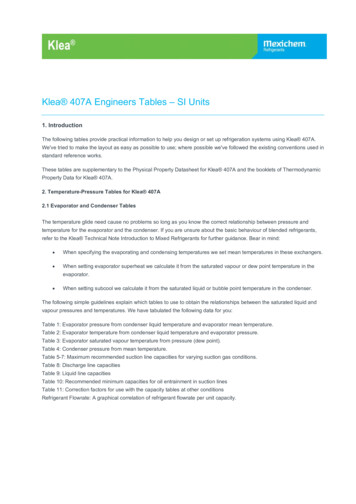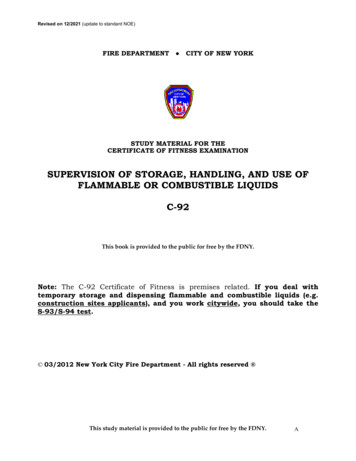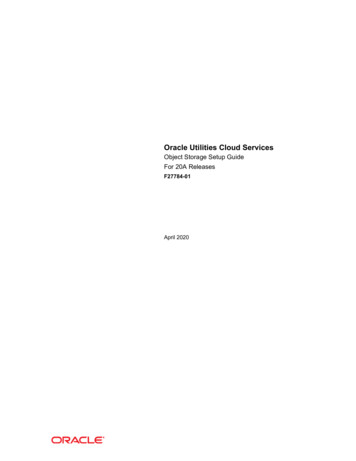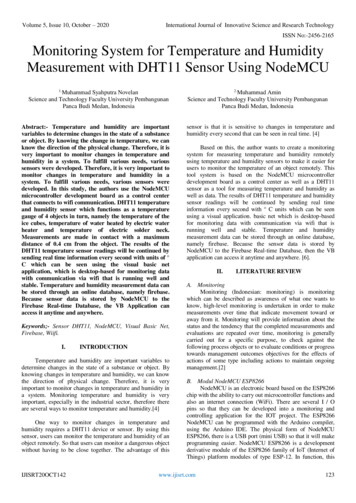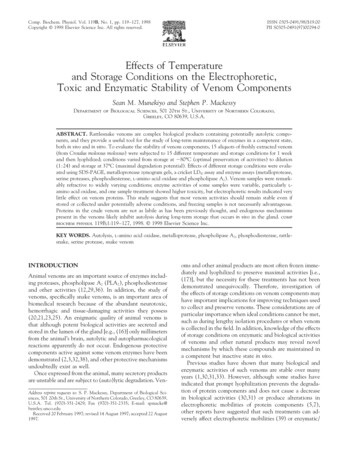
Transcription
Comp. Biochem. Physiol. Vol. 119B, No. 1, pp. 119–127, 1998Copyright 1998 Elsevier Science Inc. All rights reserved.ISSN 0305-0491/98/ 19.00PII S0305-0491(97)00294-0Effects of Temperatureand Storage Conditions on the Electrophoretic,Toxic and Enzymatic Stability of Venom ComponentsSean M. Munekiyo and Stephen P. MackessyDepartment of Biological Sciences, 501 20th St., University of Northern Colorado,Greeley, CO 80639, U.S.A.ABSTRACT. Rattlesnake venoms are complex biological products containing potentially autolytic components, and they provide a useful tool for the study of long-term maintenance of enzymes in a competent state,both in vivo and in vitro. To evaluate the stability of venom components, 15 aliquots of freshly extracted venom(from Crotalus molossus molossus) were subjected to 15 different temperature and storage conditions for 1 weekand then lyophilized; conditions varied from storage at 280 C (optimal preservation of activities) to dilution(1 :24) and storage at 37 C (maximal degradation potential). Effects of different storage conditions were evaluated using SDS-PAGE, metalloprotease zymogram gels, a cricket LD50 assay and enzyme assays (metalloprotease,serine proteases, phosphodiesterase, l-amino acid oxidase and phospholipase A2 ). Venom samples were remarkably refractive to widely varying conditions; enzyme activities of some samples were variable, particularly lamino acid oxidase, and one sample treatment showed higher toxicity, but electrophoretic results indicated verylittle effect on venom proteins. This study suggests that most venom activities should remain stable even ifstored or collected under potentially adverse conditions, and freezing samples is not necessarily advantageous.Proteins in the crude venom are not as labile as has been previously thought, and endogenous mechanismspresent in the venoms likely inhibit autolysis during long-term storage that occurs in vivo in the gland. compbiochem physiol 119B;1:119–127, 1998. 1998 Elsevier Science Inc.KEY WORDS. Autolysis, l-amino acid oxidase, metalloprotease, phospholipase A2, phosphodiesterase, rattlesnake, serine protease, snake venomINTRODUCTIONAnimal venoms are an important source of enzymes including proteases, phospholipase A2 (PLA2 ), phosphodiesteraseand other activities (12,29,36). In addition, the study ofvenoms, specifically snake venoms, is an important area ofbiomedical research because of the abundant neurotoxic,hemorrhagic and tissue-damaging activities they possess(20,21,23,25). An enigmatic quality of animal venoms isthat although potent biological activities are secreted andstored in the lumen of the gland [e.g., (16)] only millimetersfrom the animal’s brain, autolytic and autopharmacologicalreactions apparently do not occur. Endogenous protectivecomponents active against some venom enzymes have beendemonstrated (2,3,32,38), and other protective mechanismsundoubtedly exist as well.Once expressed from the animal, many secretory productsare unstable and are subject to (auto)lytic degradation. VenAddress reprint requests to: S. P. Mackessy, Department of Biological Sciences, 501 20th St., University of Northern Colorado, Greeley, CO 80639,U.S.A. Tel. (970)-351-2429; Fax (970)-351-2335; E-mail: spmacke@bentley.unco.eduReceived 20 February 1997; revised 14 August 1997; accepted 22 August1997.oms and other animal products are most often frozen immediately and lyophilized to preserve maximal activities [i.e.,(17)], but the necessity for these treatments has not beendemonstrated unequivocally. Therefore, investigation ofthe effects of storage conditions on venom components mayhave important implications for improving techniques usedto collect and preserve venoms. These considerations are ofparticular importance when ideal conditions cannot be met,such as during lengthy isolation procedures or when venomis collected in the field. In addition, knowledge of the effectsof storage conditions on enzymatic and biological activitiesof venoms and other natural products may reveal novelmechanisms by which these compounds are maintained ina competent but inactive state in vivo.Previous studies have shown that many biological andenzymatic activities of such venoms are stable over manyyears (1,30,31,33). However, although some studies haveindicated that prompt lyophilization prevents the degradation of protein components and does not cause a decreasein biological activities (30,31) or produce alterations inelectrophoretic mobilities of protein components (5,7),other reports have suggested that such treatments can adversely affect electrophoretic mobilities (39) or enzymatic/
S. M. Munekiyo and S. P. Mackessy120TABLE 1. Storage conditions of aliquots of Crotalus molossus molossus venomSamplesABCDEFGHIJKLMNOStorage TemperatureConditionsNone220 C220 C4 C4 C220 C220 C,20 C (room temperature),20 C (room temperature),20 C (room temperature)37 C37 C280 C280 C280 CImmediately frozen and lyophilized.Frozen for 1 week.Diluted (1 :24) and frozen for 1 week.Stored for 1 week.Diluted (1 :24) and stored for 1 week.Diluted (1 :24) and frozen and thawed daily for 1 week.Frozen and thawed daily for 1 week.Stored for 1 week.Diluted (1 :24) and stored for 1 week.Continuously exposed to air and stored for 1 week.Stored in a water bath for 1 week.Diluted (1 :24) and stored in a water bath for 1 week.Frozen for 1 week.Frozen and thawed daily for 1 week.Diluted (1 :24) and frozen and thawed daily for 1 week.biological activities (37). From these conflicting reports, itbecame clear that a more systematic and extensive approachto the stability of venom components was needed. Specifically, very few studies have utilized electrophoresis, toxicityassays and enzymatic activity assays to evaluate the effectsof storage conditions on venom stability [but see (22)].We hypothesized that extended exposure to temperaturesabove freezing, particularly after dilution, would result inthe degradation of enzymatic activities and change electrophoretic mobilities of some venom components. Because lyophilized venom is often reconstituted, frozen and thensubjected to freeze/thaw cycles as it is used, we also hypothesized that this process of freezing and thawing coulddamage venom components, resulting in enzymatic degradation and thus reducing the overall activities of thevenom. In the present study, the effects of varying storageconditions on protein electrophoretic mobility, zymogrammetalloprotease activity, lethal toxicity and enzymatic activities of venom were investigated. We used venom fromthe black-tailed rattlesnake (Crotalus molossus molossus) because this species produces a venom containing several potent metalloproteases (26,27) and overall caseinolytic protease activity is much higher than that observed in venomsfrom several other rattlesnake species (17). Changes invenom properties resulting from specific storage conditionsshould therefore be more pronounced in this species’venom. Activities assayed included those considered thermally more stable (PLA2 and serine proteases) and thosethat are thermally labile (l-amino acid oxidase [l-AAO]).MATERIALS AND METHODSMaterialsCasein yellow (Lot 610029) was obtained from CalBioChem, Inc., La Jolla, CA, USA. Protein concentration reagents and γ -globulin were purchased from BioRad, Inc.,Hercules, CA, USA. All other reagents (analytical gradeor better) were obtained from Sigma Chemical Co., St.Louis, MO, USA. Tris-glycine 14% acrylamide gels, Zymogram gels and Mark 12 molecular weight standards were obtained from Novel Experimental (Novex), Inc., San Diego,CA, USA. Crickets (Acheta domesticus) were purchasedfrom Fluker Farms, Inc., Baton Rouge, LA, USA.Venom Extraction and TreatmentsVenom was extracted from a healthy adult male black-tailedrattlesnake (C. m. molossus) collected in Cochise County,Arizona. The crude venom was centrifuged for 5 min atapproximately 4000 rpm to pellet cellular debris. It was thenaliquoted into 15 portions (labeled A–O) of 25 µl each.Each of these aliquots was then subjected to a different storage condition (Table 1). To evaluate the stability of thewhole venom, extremes in storage conditions were used(280 C to 137 C). After 1 week, all samples, except sample A (which was frozen and lyophilized immediately aftercentrifugation), were lyophilized. The venoms were thendissolved in 50 µl Millipore-filtered H2O, and aliquots werediluted 1 :9 with Millipore-filtered H2O. This final dilutionwas used in all experiments.Protein Concentration AssayProtein concentration was determined by a slight modification of the Bio-Rad method, using bovine gamma globulinas a standard (0, 5, 10, 15, 20, 30 and 50 µg). To each newtest tube, the following was added: Millipore-filtered H2O(795 µl), reconstituted crude venom (5 µl), and the BioRad dye reagent (200 µl). The absorbance of both the samples and standards were read at 595 nm after 5 min andwithin 20 min. Protein concentrations (determined in duplicate three times) were used to calculate gel loads, LD50dosages and enzyme specific activities.
Stability of Venom ComponentsElectrophoresisReconstituted venoms were analyzed by SDS-PAGE fortreatment-induced changes in electrophoretic mobilities ofcomponents. Tris–glycine 14% acrylamide gels were run(without 2-mercaptoethanol or boiling) as recommended bythe manufacturer [essentially the method of (11)]. Thirtyfive micrograms of venom was loaded in each lane.Venom samples were analyzed for metalloprotease activities using 10% acrylamide ‘‘Zymogram’’ gels obtained fromNovex, Inc. These gels are copolymerized with gelatin substrate. Electrophoresis and development of gels followed apublished method (8). Each lane contained 0.5 µg crudevenom. All gels were imaged using a charge coupled device(CCD) video camera with a yellow filter.121a total volume of 1.0 ml. After centrifugation, absorbanceof the supernatant was read at 285 nm; activity was expressed as A285nm /min/mg protein.Serine Protease AssaysSubstrates for thrombin-like (BzPheValArg pNA) andkallikrein-like (BzProPheArg pNA) activities were used toassay samples for two serine proteases common in crotalidvenoms (14,23). Activity, based on a p-nitroaniline standard curve, was expressed as nmol product formed/min/mgprotein. Activities toward five additional pNA-derived peptides (BzArg pNA, GluPheArg pNA, N-CbzGlyProCitpNA, N-methoxysuccinylAlaAlaProMet pNA, and GlyArgpNA) were also assayed.Toxicity AssaysDomestic crickets (A. domesticus) were used to evaluate potential changes in toxicity induced by storage conditions.Previous experiments (24) demonstrated that more consistent data were obtained using a 48-hr period for LD50 determinations with snake venoms (rather than 24 hr), and thisinterval was used for all experiments.Crickets were obtained from Fluker Farms; all were threequarter-inch sub-adults of approximately 0.5 g weight. Forall experiments, the averaged weight of 15 representativecrickets was used to calculate doses. Venom (treatments A,F, and L) was diluted to the appropriate dose/g body weightin cricket Ringer solution (150 mM NaCl, 7 mM KCl, 8mM CaCl2, 4 mM MgCl2) (40). Initial experiments showedthat handling of crickets and injection with cricket Ringersolution had no effect on 48-hr LD50 (i.e., control injectionsproduced no mortality).Intraperitoneal injections of 10 µl were administered to15 crickets at each dose level; seven dose levels were evaluated (0.05–10.0 µg/g body weight). Crickets were gentlyrestrained while the needle of a 25-µl Hamilton syringe wasinserted 4–5 mm at an angle of approximately 30 degrees.All injections were made behind the center of the fifth abdominal segment. All crickets were housed with food andwater ad libitum at 26 C and checked at 24 and 48 hr postinjection. Percent mortality at 48 hr as a function of dose(semi-log plot; Sigma Graphics) was used to determine LD50values. The cricket model, although obviously differingphysiologically from mammalian models, provides repeatable data on acute toxicity (LD50). Additionally, initial testing with invertebrates can help decrease the number of vertebrates used in subsequent assays, a goal consistent withconcerns about vertebrate use in toxicity tests.Caseinolytic Protease AssayCaseinolytic protease activity was assayed by a method described previously (15) using 5 µl reconstituted venom inL-Amino Acid Oxidase Assayl-AAO activity was assayed as described previously (17).The activity, based on a kynurenic acid standard curve, wasexpressed as nmol product formed/min/mg protein.Phospholipase A2 AssayPLA 2 activity was assayed by an aqueous method (10). Theabsorbance of the samples was read at 425 nm after 5 minand within 1 hr. Activity, based on a nitrobenzoic acid standard curve, was expressed as nmol product formed/min/mgprotein.Phosphodiesterase AssayPhosphodiesterase activity was assayed as described previously (18). Activity was expressed as A400nm /min/mg protein.RESULTSProtein electrophoretic mobilities, toxicity and enzymaticactivities of black-tail rattlesnake venom were largely unaffected by a wide variety of treatment and storage conditions.The various treatments showed only a few conditions thatcaused significant changes in activity of the venom components.All samples had the same major banding patterns on 14%acrylamide gels (SDS-PAGE). At least 24 protein bands,ranging in size from approximately 6–250 kD, were visualized in all sample treatments (Fig. 1A and B). Nearly all ofthese protein bands had the same intensity, with the exception of sample L. In this sample treatment (diluted1 :24 and stored for 1 week at 37 C), several higher molecular weight bands were missing or less intense. This includeda minor band at approximately 78 kD and two major bandsat approximately 63 and 58 kD. A minor lower molecular
122S. M. Munekiyo and S. P. MackessyFIG. 1. (A and B). Electrophoretic mobility of C. m. molos-sus venom components after storage under various conditions (see Table 1). Sample concentrations were 35 mg/lane.Note similarities of banding patterns in all lanes except laneL. Sample L shows decreased intensity of major bands at 63and 58 kD, and an additional band at 53 kD (arrowheads).weight band (approximately 53 kD) was present in sampleL, but absent from other samples, indicating a potentialproduct of autolysis.A high degree of similarity was also seen in the 10%acrylamide Zymogram gels, which detect metalloproteaseactivity (Fig. 2A and B). Four distinct regions of proteaseactivity were observed for all samples at approximately 61,56, 27 and 24 kD. No differences in band position or intensity were noted between samples regardless of the treatment.Toxicities of samples A (immediately frozen and lyophilized), F (diluted 1 :24 and frozen/thawed daily) and L (diluted 1:24 and stored at 37 C) are shown in Fig. 3. SamplesA and F showed identical toxicity profiles and a 48-hr LD50in crickets of 0.54 µg/g. Sample L showed an apparent 2fold greater toxicity, and the 48-hr LD50 was 0.23 µg/g. Allsamples produced 100% mortality at 48 hr at doses of 1.0µg/g or greater.Enzyme activities were somewhat variable but largely un-FIG. 2. (A and B). Electrophoretic zymogram of venomstored under various conditions. Sample concentrationswere 0.2 mg/lane. Metalloproteases appear as white bands atapproximately 61, 56, 27 and 24 kD. Note the constancyof protease banding patterns regardless of storage treatment.The diagonal dark bar in A is a photographic artifact.affected by extremes in storage conditions. Figure 4 summarizes effects of storage treatment on six enzyme activities.In virtually all cases, sample L (diluted 1 :24 and stored at37 C) showed higher activity than all other treatments, andin most cases, sample E (diluted 1:24 and stored at 4 C)showed the lowest activity.Figure 5 illustrates the effects of each differential storagecondition on enzyme activities. Caseinolytic protease activity of sample A (frozen at 220 C and lyophilized immediately) showed the lowest level (Fig. 5A); two treatments,sample J (stored at room temperature and air dried) andsample L, had significantly higher activity.Thrombin-like venom protease activities (Fig. 5B) werelargely uniform but lower in the sample treatment E (diluted1 :24 and stored at 4 C). The treatment that showed significantly higher activity was sample L (diluted 1:24 andstored at 37 C). The kallikrein-like protease activities (Fig.
Stability of Venom Components123L. All venom samples showed extremely low or no activitytoward five other pNA substrates (BzArg pNA, GluPheArgpNA, N-CBzGlyProCit pNA, N-methoxysuccinylAlaAlaProMet pNA and GlyArg pNA).The activities of the l-AAO (Fig. 5D) were most variable. The lowest activity level was found in sample I (diluted 1:24 and stored at room temperature); samples A (frozen at 220 C and lyophilized immediately) and L showedthe highest activities. A 3-fold range of variation (13–38nmol/min/mg) was seen in activities of this enzyme. PLA2activities (Fig. 5E) were fairly uniform. The lowest activities, only slightly lower than the average, were found withsamples C (diluted 1 :24 and stored at 220 C), E and I.Samples J (stored at room temperature and air dried) andL had the highest activities. Phosphodiesterase activity ofall eight samples that were frozen showed higher activitiesthan those not frozen, except samples J and L (Fig. 5F).The lowest activity levels were seen in samples E and I, andsample L once again showed much higher activity than allother treatments.FIG. 3. Lethality of venom samples stored under several con-ditions: semilog plot. Toxicity of three venom samples (A,F and L) was evaluated in crickets as described in Materialsand Methods. Samples A (Lyophilized immediately) and F(diluted 1 :24 and freeze/thawed) had identical values (0.54mg/g); sample L (diluted 1 :24 and stored at 37 C) had agreater apparent toxicity (0.23 mg/g).5C) were somewhat more variable than the thrombin-likeactivity; however, most sample activities, in particular thosestored at above-freezing temperatures, were uniform. Sample E was slightly lower than the average and again, thetreatment that was much higher than average was sampleFIG. 4. Effect of storage conditions on enzyme activities. Theaverage value of each enzyme assay for all treatments wasset at 100%; each point represents [treatment value 4 average value] 3 100%. CP, caseinolytic protease; THR, thrombin-like protease; KAL, kallikrein-like protease; L-AAO, Lamino acid oxidase; PLA2, phospholipase A2 ; PDE, phosphodiesterase.DISCUSSIONResults of this study are consistent with several earlier studies (1,31). Previous investigators (1) found that the effectsof preparatory procedures had little effect on the stabilityof C. m. molossus venom protein banding patterns after isoelectric focusing. An early study (31) found that LD50 valueswere largely unaffected by crude or lyophilized venom storage conditions. However, lethality of venom results from asynergistic interplay of venom components, including enzymes, peptides and specific toxins, and it is possible thatisoelectric focusing patterns could remain stable even ifcomponents were denatured by storage conditions. Thepresent study examined protein banding patterns (electrophoretic profiles), toxicity and specific enzyme activities ofvenom components with presumed differential stabilities.Venom from C. m. molossus was used in this study becausemetalloprotease activity is extremely high and autolyticdegradation loss of activity should be quite pronounced forthis venom. Further, as demonstrated by comparative enzyme assays and zymogram gel assays (Mackessy, unpublished data), C. m. molossus venom has many of the sameenzymes present in the venoms of other large species of Crotalus (such as C. atrox, C. mitchelli, C. scutulatus), and resultsshould therefore be generalizable to other viperid species.Although it was initially hypothesized that the integrityand stability of venom components would be adversely affected by dilution, freeze-thawing cycles and higher storagetemperatures, the results from electrophoretic assays demonstrated that the venom protein components were not altered electrophoretically when stored and lyophilized, consistent with previous reports (1,5,7). Additionally, themajor banding patterns observed after the different treatments in this study were all similar with those observed in
124S. M. Munekiyo and S. P. MackessyFIG. 5. Histogram distribution of specific activity levels of six enzyme activities for venom samples stored under 15 differentconditions (see Table 1). A, Caseinolytic protease; B, thrombin-like protease; C, kallikrein-like protease; D, L-amino acidoxidase; E, phospholipase A2 ; F, phosphodiesterase.other electrophoretic studies (4,34) of C. m. molossusvenom.The pattern of major and minor bands for C. m. molossusvenom were very similar for all storage conditions; onlysample L (diluted 1:24 and stored at 37 C) had some minordifferences. In this sample, two major bands (approximately63 and 58 kD) were less intense than in other samples andone minor band (approximately 78 kD) was not observedin sample L but was present in all other samples. A secondminor band (approximately 53 kD) was observed in sampleL but was not seen in any other sample. The lower intensityof the two major bands and the absence of the minor bandmay be attributed to autolytic degradation promoted by dilution and high temperature conditions. The additional minor band could likely have resulted from degradation ofhigher molecular weight components.Electrophoretic consistency was also observed for the zymogram gels, which provide a first approximation of thenumber of molecular weight classes of metalloproteases invenoms. Regardless of treatment, all lanes showed the same
Stability of Venom Componentspattern of four protease bands, an observation that is particularly noteworthy because purified metalloprotease fromCrotalus viridis oreganus venom, which is homologous withthe 61-kD band, underwent autolytic degradation when thepurified protease was stored in solution (13). Apparently,components present in the intact crude venom preventedautolysis of metalloproteases, even after storage at 37 C.The cricket LD50 assay was developed as an alternativeto the mouse model, in part in response to growing criticismof vertebrate toxicity studies. Although mammalian and insect physiology differ significantly, the cricket model allowed comparison of organism-level toxicity of complexmaterials such as venoms (24). All three C. m. molossussamples tested showed comparable toxicity; however, sample L (diluted and stored at 37 C) showed half the apparentLD50 value. It should be noted that using identical routesof administration, different investigators have found mouseLD50 values for the same venom that have differed by asmuch as a factor of 4 (6). The cricket assays demonstratedthat differential storage of venom did not result in a loss ofbiological activity (toxicity) and the cricket 48-hr LD50model is a useful alternative for initial toxicity screening.The cricket 48-hr LD50 model has several advantages oververtebrate model systems. It retains a desirable aspect of thetoxicity assays (complex systems interactions, whole organism instead of cellular toxicity or in vitro diagnostics), butit avoids the use of vertebrates. Many researchers have beenattempting to minimize the use of vertebrates in acute studies, and the cricket model provides a means for initial toxicity screenings that will decrease the number of vertebratesneeded for secondary tests. Because crickets have an adultbody weight of ,0.5 g (vs a 20 to 25-g mouse), very smallamounts of valuable samples can be assayed at numerousdosages using a statistically significant number of animals.In addition, because crickets are commercially available, aresmall and are easily housed and maintained, overall costsfor LD50 assays are significantly reduced. It should be reiterated that this model was designed to augment existing models and to decrease the numbers of vertebrates required forsecondary testing; it is not suggested to replace mousemodels.Although venom samples appeared electrophoreticallystable under nearly all temperature and storage conditions,venom enzyme activity was somewhat variable. Several general trends are apparent from the enzyme assays. Unlikemany macromolecules in solution, venom samples were remarkably stable to freeze/thaw cycles, and most activitiesassayed were not negatively affected by such cycling. Onenotable exception was l-AAO, the enzyme that showed thegreatest overall variation with storage condition; previousstudies have demonstrated the thermal lability of l-AAO(35). For this activity only, 220 C/120 C freeze/thaw cycles of undiluted venom significantly decreased apparent enzyme activity; all other enzymes assayed were unaffected byfreeze/thaw cycles. In contrast, the sample that was diluted125and stored at 4 C for 1 week (sample E) showed the lowestlevels of activity for all enzymes except l-AAO. Because lyophilized venoms are typically rehydrated at concentrationswell below original protein concentrations (,80–120 mg/ml), storage of rehydrated samples frozen between assaysshould preserve most activities and is recommended. Appropriate storage of rehydrated samples is particularly important for comparative studies.Caseinolytic protease activity generally was higher afterstorage at 4 C, whereas preservation of kallikrein-like activity was promoted by freezing storage. Under short-termintense heating (100 C for 5 min), a recent study (22)found C. m. molossus venom showed an increase in caseinolytic protease activity in comparison with those samplesthat were not heated. Under long-term and less intenseheating (37 C for 7 days, samples K and L), sample L (diluted 1 :24) showed a large increase in activity (approximately 35% above average); activity of sample K (undiluted) did not vary significantly from the mean value. Anunexpected and difficult to explain observation is the increased toxicity and enzyme activities of sample L. For allactivities assayed, dilution and warm storage significantlyincreased apparent activities and toxic potency to the highest levels noted. Only slight changes in sample L were observed after SDS-PAGE, but it may be possible that a concentration and/or temperature-dependent inhibitor wasdegraded during this treatment; conversely, an activatormay have been stimulated. Peptide and protein inhibitors ofseveral venom components have been isolated from snakevenoms [e.g., (2,9,28)], so it is conceivable that degradationof a functionally similar component could have producedthe increased activity levels observed. In the absence of anendogenous peptide inhibitor, proteases from Bothrops aspervenom degraded several venom myotoxins (2). This phenomenon of heat activation of venom enzymes is being investigated further using venoms from different species of rattlesnakes.One potential limitation of this study is that venom fromonly one species of rattlesnake was tested. It is conceivablethat venoms from different species and/or different familiesof snakes could show differential sensitivities to the storageconditions reported above. However, this is unlikely for several reasons. First, many, perhaps most, species of rattlesnakes produce venoms containing numerous metalloproteases (most likely to destabilize other venom components),and many of these proteases are homologous between species (Mackessy, unpublished data). Second, among PLA2sfrom venoms, for which many sequences of enzymes fromthree families of snakes are available (29), a high degreeof homology is observed, indicating that venoms from verydifferent snakes share some basic similarities; this suggeststhat storage mechanisms may also show similarities. Finally,endogenous enzyme inhibitors have been isolated from crotalid, elapid and viperid snakes (2,3,9,28), further indicating a common response to potential storage problems. We
126believe that the results obtained with C. m. molossus venomcan be generalized to all front-fanged snake venoms; nevertheless, venoms from other species will need to be examinedto confirm or refute this hypothesis.Results of this study have shown that electrophoretic,toxic and representative enzymatic activities of blacktailrattlesnake venom, a complex biological secretion containing at least 24 distinct protein components, are largelyunaffected by storage conditions varying by as much as117 C. The fact that no loss of activities was observed inthe normal range of ambient temperatures experienced bythe snake in the field (approximately 0–37 C) demonstrates that endogenous stabilizers or inhibitors must bepresent in the gland and the venom stored in the lumen.Further, as demonstrated electrophoretically for all sampletreatments except sample L, protein components did notundergo detectable autolytic degradation, despite the presence of at least four discrete size classes of metalloproteaseswith endoprotease (casein, gelatin) activity. Snake venomsin the crude expressed state appear quite stable regardlessof whether or not freezing occurs promptly. It is probablethat for most species, collection of venom samples in thefield followed by cool storage (i.e., non-extreme temperatures) will produce samples of quality comparable with thoseobtained in the laboratory. We have used this procedure toobtain venom samples of an endangered species occurringin a remote location (19) where removal of animals to alaboratory setting was not possible, and activities of samplesare comparable with those of samples obtained from twocaptive specimens. For isolation of components with thehighest specific activities, it may be necessary to proceedfrom venom extraction to the isolation procedure directly,because lyophilization has been suggested to decrease someactivities (37); however, this will rarely be possible. To preserve maximum activity for veno
H ,20 C (room temperature) Stored for 1 week. I ,20 C (room temperature) Diluted (1:24) and stored for 1 week. J ,20 C (room temperature) Continuously exposed to air and stored for 1 week. K37 C Stored in a water bath for 1 week. L37 C Diluted (1:24) and stored in a water bath for 1 week. M 280 C Frozen for 1 week.




